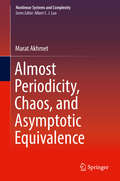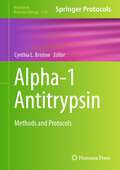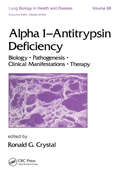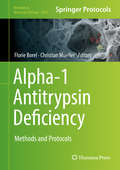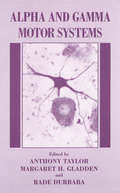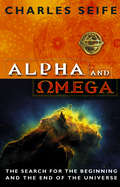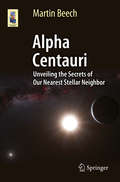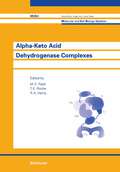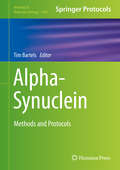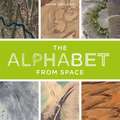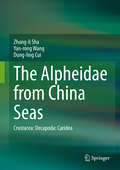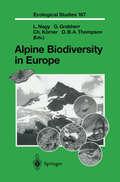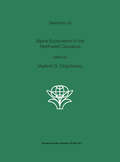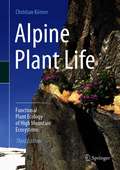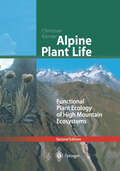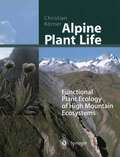- Table View
- List View
Almost Periodicity, Chaos, and Asymptotic Equivalence (Nonlinear Systems and Complexity #27)
by Marat AkhmetThe central subject of this book is Almost Periodic Oscillations, the most common oscillations in applications and the most intricate for mathematical analysis. Prof. Akhmet's lucid and rigorous examination proves these oscillations are a "regular" component of chaotic attractors. The book focuses on almost periodic functions, first of all, as Stable (asymptotically) solutions of differential equations of different types, presumably discontinuous; and, secondly, as non-isolated oscillations in chaotic sets. Finally, the author proves the existence of Almost Periodic Oscillations (asymptotic and bi-asymptotic) by asymptotic equivalence between systems. The book brings readers' attention to contemporary methods for considering oscillations as well as to methods with strong potential for study of chaos in the future. Providing three powerful instruments for mathematical research of oscillations where dynamics are observable and applied, the book is ideal for engineers as well as specialists in electronics, computer sciences, robotics, neural networks, artificial networks, and biology.Distinctively combines results and methods of the theory of differential equations with thorough investigation of chaotic dynamics with almost periodic ingredients;Provides all necessary mathematical basics in their most developed form, negating the need for any additional sources for readers to start work in the area;Presents a unique method of investigation of discontinuous almost periodic solutions in its unified form, employed to differential equations with different types of discontinuity;Develops the equivalence method to its ultimate effective state such that most important theoretical problems and practical applications can be analyzed by the method.
Alpha-1 Antitrypsin: Methods and Protocols (Methods in Molecular Biology #2750)
by Cynthia L. BristowThis volume provides a collection of protocols that will allow researchers to further explore the multiple, fascinating activities of Alpha-1 Antitrypsin (AAT) isoforms in innate immunity, and gene therapy. Written in the highly successful Methods in Molecular Biology series format, chapters include introductions to their respective topics, lists of the necessary materials and reagents, step-by-step, readily reproducible laboratory protocols, and tips on troubleshooting and avoiding known pitfalls. Authoritative and cutting-edge, Alpha-1 Antitrypsin: Methods and Protocols aims to ensure successful results in the further study of this vital field.
Alpha 1 - Antitrypsin Deficiency: Biology-Pathogenesis-Clinical Manifestations-Therapy
by Ronald G. CrystalProviding a broad overview of basic and clinical aspects of alpha 1-antitrypsin (a 1AT) deficiency, this up-to-date reference discusses the complex pathobiological processes underlying the pathogenesis of a1AT deficiency, describes the a1AT gene and its promoter, and details specific therapies to prevent the major clinical manifestations of the dis
Alpha-1 Antitrypsin Deficiency: Methods and Protocols (Methods in Molecular Biology #1639)
by Florie Borel and Christian MuellerThis volume provides protocols that expand on the latest alpha-1-antitrypsin (AAT) research. The chapters in this book are divided in to three sections: Part I is dedicated to patient-oriented research; part II discusses animal models; and Part III focuses on in vitro studies. Written in the highly successful Methods in Molecular Biology series format, chapters include introductions to their respective topics, lists of the necessary materials and reagents, step-by-step, readily reproducible laboratory protocols, and tips on troubleshooting and avoiding known pitfalls. Cutting-edge and authoritative, Alpha-1 Antitrypsin Deficiency: Methods and Protocols is a valuable resource for researchers, students, and clinican-scientists interested in AAT deficiency, as well as anyone working in the fields of pulmonology and hepatology.
Alpha and Beta emissions (large print)
by RnibThere are two labelled diagrams on this page. The image at the top of the page shows the creation of an alpha particle, the image at the bottom, a beta particle. There is a locator dot shown, which will be at the top left of the page when the image is the correct way up. Each of the images is surrounded by a dashed line image border. In the diagram at the top of the page the nucleus at the left of the page is emitting an alpha particle and so changes from Thorium to Radium. This is shown in the formula in the bottom of the diagram. In the diagram at the bottom of the page the nucleus at the left of the page is emitting a beta particle and so changes from Potassium to Calcium. This is shown in the formula in the bottom of the diagram.
Alpha and Beta emissions (UEB contracted)
by RnibThere are two labelled diagrams on this page. The image at the top of the page shows the creation of an alpha particle, the image at the bottom, a beta particle. There is a locator dot shown, which will be at the top left of the page when the image is the correct way up. Each of the images is surrounded by a dashed line image border. In the diagram at the top of the page the nucleus at the left of the page is emitting an alpha particle and so changes from Thorium to Radium. This is shown in the formula in the bottom of the diagram. In the diagram at the bottom of the page the nucleus at the left of the page is emitting a beta particle and so changes from Potassium to Calcium. This is shown in the formula in the bottom of the diagram.
Alpha and Beta emissions (UEB uncontracted)
by RnibThere are two labelled diagrams on this page. The image at the top of the page shows the creation of an alpha particle, the image at the bottom, a beta particle. There is a locator dot shown, which will be at the top left of the page when the image is the correct way up. Each of the images is surrounded by a dashed line image border. In the diagram at the top of the page the nucleus at the left of the page is emitting an alpha particle and so changes from Thorium to Radium. This is shown in the formula in the bottom of the diagram. In the diagram at the bottom of the page the nucleus at the left of the page is emitting a beta particle and so changes from Potassium to Calcium. This is shown in the formula in the bottom of the diagram.
Alpha and Gamma Motor Systems
by R. Durbaba M. H. Gladden Anthony TaylorThe Sherrington School of Physiology at St. Thomas' Hospital provided a natural venue for four days of enthusiastic debate on Sherrington's Final Common Path -the alpha motoneurone and related matters; Sherrington himself held a lecturership at St. Thomas' just over a century ago. The occasion was a happy one. Most participants already knew each other, the topics were familiar, the discussion was vigorous and critical but without personal rancor. The program had set out to encourage debate with 'critiques' both of the oral papers and the posters; their inclusion in the present volume helps to show where we are standing on rock rather than sand. In spite of a venerable history some surprisingly simple matters remain controversial, such as the information content of the signals from the Golgi tendon organs. To those working on alpha and gamma motoneurones and their control this volume provides an essential up-dating. Classical problems continue to be attacked on a broad front; advance is steady and continuous, a swelling tide rather than a sudden view of the summit. But in some sectors the difficulties are so great that to the outsider little might seem to change, the same battles continuing; but even here, the terms of debate change and concensus develops. Other branches of biology claim breakthrough upon breakthrough from the routine application of the new technologies, so we have to be the first to ask whether our classical approach to science can still be justified.
Alpha And Omega: The Search For The Beginning And The End Of The Universe
by Charles SeifeSince A BRIEF HISTORY OF TIME scientists have been in the midst of a revolution in cosmology. Gradually, astronomers and physicists are answering questions that have plagued mankind since prehistory: how was the universe born, how will it end? They are even now peering into the cradle of the universe - and into its grave. By the beginning of next year, scientists will have a clue to some of the answers. These will be among the greatest triumphs of science.This book tells that story and will reveal results of the most advanced experiments in cosmology ever conducted. It's a tale of men solving the insoluble, of the controversy and anger of rivals after the same goal. Even more thrillingly - it is a lucid explanation of new scientific ideas that stretch man's powers of understanding to their highest levels.
Alpha Centauri: Unveiling the Secrets of Our Nearest Stellar Neighbor (Astronomers' Universe)
by Martin BeechAs our closest stellar companion and composed of two Sun-like stars and a third small dwarf star, Alpha Centauri is an ideal testing ground of astrophysical models and has played a central role in the history and development of modern astronomy—from the first guesses at stellar distances to understanding how our own star, the Sun, might have evolved. It is also the host of the nearest known exoplanet, an ultra-hot, Earth-like planet recently discovered.Just 4.4 light years away Alpha Centauri is also the most obvious target for humanity’s first directed interstellar space probe. Such a mission could reveal the small-scale structure of a new planetary system and also represent the first step in what must surely be humanity’s greatest future adventure—exploration of the Milky Way Galaxy itself.For all of its closeness, α Centauri continues to tantalize astronomers with many unresolved mysteries, such as how did it form, how many planets does it contain and where are they, and how might we view its extensive panorama directly?In this book we move from the study of individual stars to the study of our Solar System and our nearby galactic neighborhood. On the way we will review the rapidly developing fields of exoplanet formation and detection.
Alpha-Keto Acid Dehydrogenase Complexes (Molecular and Cell Biology Updates)
by M. S. Patel T. E. Roche R. A. HarrisFound in all organisms, the alpha-keto acid dehydrogenase complexes have central roles in cellular metabolism and are major sites of regulation. The understanding of the organization, function and regulation of these quintessential multienzyme complexes has been greatly advanced by studies employing molecular biology and biophysical techniques. Although these enzyme systems have some features in common, their diversity in fulfilling unique organism - or tissue - specific roles is truly amazing. These systems have medical importance in areas ranging from defects in regulation (linked to diabetes, heart disease, obesity, nutrition defects), to inherited diseases (inborn errors, maple syrup urine disease) to acquired immune diseases (primary biliary cirrhosis). This book brings together wide-ranging recent findings on the structure(function relationships, gene regulation, and genetic defects of the alpha-keto acid dehydrogenase complexes, namely the pyruvate dehydrogenase, alpha-ketoglutarate dehydrogenase and the branched-chain alpha-keto acid dehydrogenase complexes. A wide variety of experimental approaches together with new results presented in this book should serve as a resource for beginning to established investigators in the field as well as scientists who are interested in mitochondria, dehydrogenases, kinases, phosphatases, lipoic acid, thiamine pyrophosphate, and enzyme complexes.
Alpha particle paths (large print)
by RnibThis is a labelled diagram showing how some alpha particles are deflected by the nuclei of metal atoms. There is a locator dot shown, which will be at the top left of the page when the image is the correct way up. The alpha particles are shown on the left of the page as they start their journey moving to the right. They are represented by small dots and their paths are shown as arrowed lines. The paths pass through a group of eight atoms to the right, represented by large circles. Some of the particles collide with the atoms' nuclei, shown as small circles with crosses at their centre, and are deflected up or down the page. Some of the particles pass through the outer shells of the atoms and are not deflected, so they continue travelling in a straight line to the right.
Alpha particle paths (UEB contracted)
by RnibThis is a labelled diagram showing how some alpha particles are deflected by the nuclei of metal atoms. There is a locator dot shown, which will be at the top left of the page when the image is the correct way up. The alpha particles are shown on the left of the page as they start their journey moving to the right. They are represented by small dots and their paths are shown as arrowed lines. The paths pass through a group of eight atoms to the right, represented by large circles. Some of the particles collide with the atoms' nuclei, shown as small circles with crosses at their centre, and are deflected up or down the page. Some of the particles pass through the outer shells of the atoms and are not deflected, so they continue travelling in a straight line to the right.
Alpha particle paths (UEB uncontracted)
by RnibThis is a labelled diagram showing how some alpha particles are deflected by the nuclei of metal atoms. There is a locator dot shown, which will be at the top left of the page when the image is the correct way up. The alpha particles are shown on the left of the page as they start their journey moving to the right. They are represented by small dots and their paths are shown as arrowed lines. The paths pass through a group of eight atoms to the right, represented by large circles. Some of the particles collide with the atoms' nuclei, shown as small circles with crosses at their centre, and are deflected up or down the page. Some of the particles pass through the outer shells of the atoms and are not deflected, so they continue travelling in a straight line to the right.
Alpha particle scattering (large print)
by RnibThis page shows a labelled diagram of an apparatus to detect alpha particles deflected by the nuclei of metal atoms, and measure their angle of deflection. There is a locator dot shown, which will be at the top left of the page when the image is the correct way up. The apparatus is on the left of the page. In the bottom right of the image is symbol representing the eye of an observer viewing the deflected particles through the microscope.
Alpha particle scattering (UEB contracted)
by RnibThis page shows a labelled diagram of an apparatus to detect alpha particles deflected by the nuclei of metal atoms, and measure their angle of deflection. There is a locator dot shown, which will be at the top left of the page when the image is the correct way up. The apparatus is on the left of the page. In the bottom right of the image is symbol representing the eye of an observer viewing the deflected particles through the microscope.
Alpha particle scattering (UEB uncontracted)
by RnibThis page shows a labelled diagram of an apparatus to detect alpha particles deflected by the nuclei of metal atoms, and measure their angle of deflection. There is a locator dot shown, which will be at the top left of the page when the image is the correct way up. The apparatus is on the left of the page. In the bottom right of the image is symbol representing the eye of an observer viewing the deflected particles through the microscope.
Alpha-Synuclein: Methods and Protocols (Methods in Molecular Biology #1948)
by Tim BartelsThis volume provides the reader with detailed protocols that describe a variety of in vitro and in vivo techniques that study reductionist systems and human samples. The methods covered in this book explore a broad selection of topics such as functional aspects of alpha-synuclein biology, its lipid-interactions and misfolding, and functional deficits in cells and mice. Chapters also cover topics such as kinetic measurements of endocytosis and exocytosis in cultured neurons; electrochemiluminescence-based detection; yeast-based screens to target alpha-synuclein toxicity; mass-spectrometry of alpha-synuclein in rat cortical neurons; and expression and purification of untagged a-synuclein. Written in the highly successful Methods in Molecular Biology series format, chapters include introductions to their respective topics, lists of the necessary materials and reagents, step-by-step, readily reproducible laboratory protocols, and tips on troubleshooting and avoiding known pitfalls.Cutting-edge and thorough, Alpha-Synuclein: Methods and Protocols is a valuable reference guide that aids researchers working on topics related to alpha-synuclein and its various aspects.
The Alphabet From Space
by Adam Voiland'Aloha, A! What begins with A? There is Antarctica, Azerbaijan, algal blooms, and alluvial fans. Astronauts appreciating awe-inspiring views of Earth from above. And these ancient Appalachian ridges in America intersected by an azure river in autumn!'We've all looked up at clouds and found faces, objects and animals within their white puffy shapes. Astronauts and satellites can do the same thing - but from far above in outer space...While working on a story about wildfires in northern Canada, NASA science writer and new father Adam Voiland found a stunning satellite image of an enormous smoke cloud, many miles across, shaped like the letter 'V'. The majesty of that image made Adam wonder: could he track down all 26 letters of the alphabet for his newborn baby son, using only satellite imagery and photographs of the Earth taken by astronauts? With the help of readers and colleagues at NASA, he started to collect images of clouds, blooms of sea plankton and dust storms that formed shapes reminiscent of all the letters from A to Z.The result is this beautiful book of earth imagery. It offers a unique view of the alphabet, where letters are spelled out by rivers, deserts, mountains and ice. At a time when Space travel is more popular than ever, and astronauts from Chris Hadfield to Tim Peake are inspiring a whole generation of young readers, this book is a delight for adults and children alike. It is at once a celebration of Space, language and the natural beauty of our home planet, and a gift to keep for ever.
The Alpheidae from China Seas: Crustacea: Decapoda: Caridea
by Zhong-li Sha Yan-rong Wang Dong-ling CuiAs one of the largest families within the Caridea, the Alpheidae have attracted much attention for its species richness, especially on coral reefs. The Alpheidae are one of the most abundant decapods in tropical and subtropical areas, with 48 genera and more than 700 known species. The Alpheidae present a particular challenge in terms of both taxonomy and systematics as they are difficult to identify (some species vary in their growth and there are often large differences between the sexes). Traditional, morphology-based research on the Alpheidae still plays an important role in identifying species, compared with new methods, such as the short gene sequences. Based on more than 2000 specimens collected from the China Seas, this book describes and clearly illustrates 146 species belonging to 16 genera of the Alpheidae. It also presents the key features of every genus and every species within every genus, to enable readers to easily identify the alphid shrimps of the China Seas.
Alpine Biodiversity in Europe (Ecological Studies #167)
by Laszlo Nagy Georg Grabherr Christian Körner Desmond B. A. ThompsonThe United Nations Conference on the Environment and Development (UNCED), held in Rio de Janeiro in 1992, spawned a multitude of pro grammes aimed at assessing, managing and conserving the earth's biological diversity. One important issue addressed at the conference was the mountain environment. A specific feature of high mountains is the so-called alpine zone, i. e. the treeless regions at the uppermost reaches. Though covering only a very small proportion of the land surface, the alpine zone contains a rela tively large number of plants, animals, fungi and microbes which are specifi cally adapted to cold environments. This zone contributes fundamentally to the planet's biodiversity and provides many resources for mountain dwelling as well as lowland people. However, rapid and largely man-made changes are affecting mountain ecosystems, such as soil erosion, losses of habitat and genetic diversity, and climate change, all of which have to be addressed. As stated in the European Community Biodiversity Strategy, "the global scale of biodiversity reduction or losses and the interdependence of different species and ecosystems across national borders demands concerted international action". Managing biodiversity in a rational and sustainable way needs basic knowledge on its qualitative and quantitative aspects at local, regional and global scales. This is particularly true for mountains, which are distributed throughout the world and are indeed hot spots of biodiversity in absolute terms as well as relative to the surrounding lowlands.
Alpine Ecosystems in the Northwest Caucasus (Geobotany #29)
by Vladimir G. OnipchenkoPlant geographical description of the area, syntaxonomy, spatial patterns, floristic richness, structure of plant communities in relation to soil properties and herbivore influence were described for a mountain region that is difficult to access. Seasonal, inter-annual, and long-term dynamics of vegetation are discussed on the base of long-term observations as well as pollen and phytolith analyses. Population biology of alpine plants is studied by combination of field observations and mathematical modelling. Plant population strategies and soil seed banks are described for alpine plants from several communities. Results of long-term ecological experiments (plant reciprocal transplantations, dominant removals, light limitation) showed the significance of competition and facilitation for community organization. Structure of soil algal and fungal communities is represented as well as mycorrhiza of alpine plants. Main animal groups (wild) history and modern nature conservation problems are discussed.
Alpine Plant Life: Functional Plant Ecology of High Mountain Ecosystems
by Christian KörnerThis book is a completely revised, substantially extended treatment of the physical and biological factors that drive life in high mountains. The book covers the characteristics of alpine plant life, alpine climate and soils, life under snow, stress tolerance, treeline ecology, plant water, carbon, and nutrient relations, plant growth and productivity, developmental processes, and two largely novel chapters on alpine plant reproduction and global change biology. The book explains why the topography driven exposure of plants to dramatic micro-climatic gradients over very short distances causes alpine biodiversity to be particularly robust against climatic change. Geographically, this book draws on examples from all parts of the world, including the tropics. This book is complemented with novel evidence and insight that emerged over the last 17 years of alpine plant research. The number of figures – mostly in color – nearly doubled, with many photographs providing a vivid impression of alpine plant life worldwide.Christian Körner was born in 1949 in Austria, received his academic education at the University of Innsbruck, and was full professor of Botany at the University of Basel from 1989 to 2014. As emeritus Professor he is continuing alpine plant research in the Swiss Alps.
Alpine Plant Life: Functional Plant Ecology of High Mountain Ecosystems
by Christian KörnerGenerations of plant scientists have been fascinated by alpine plant life - with the exposure of organisms to dramatic climatic gradients over a very short distance. This comprehensive text treats a wide range of topics: alpine climate and soils, plant distribution and the treeline phenomenon, physiological ecology of water-, nutritional- and carbon relations of alpine plants, plant stress and plant development, biomass production, and aspects of human impacts on alpine vegetation. Geographically the book covers all parts of the world including the tropics.This second edition of Alpine Plant Life gives new references, new diagrams, and extensively revised chapters.
Alpine Plant Life: Functional Plant Ecology of High Mountain Ecosystems
by Christian KörnerGenerations of plant scientists have been fascinated by alpine plant lifean ecosystem that experiences dramatic climatic gradients over a very short distance. This comprehensive book examines a wide range of topics including alpine climate and soils, plant distribution and the treeline phenomenon, plant stress and development, global change at high elevation, and the human impact on alpine vegetation. Geographically, the book covers all parts of the world including the tropics.
